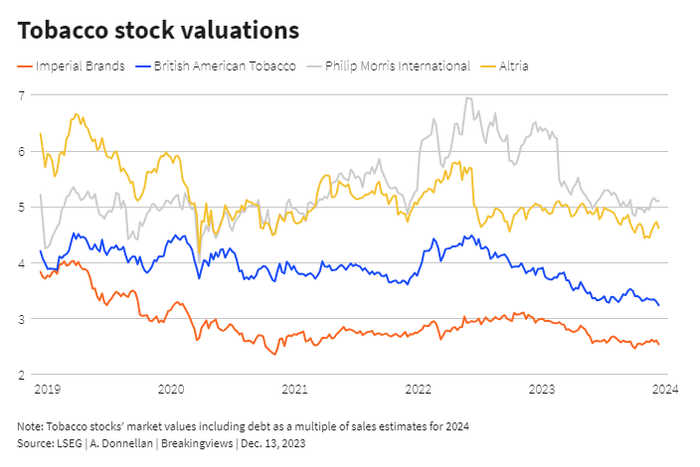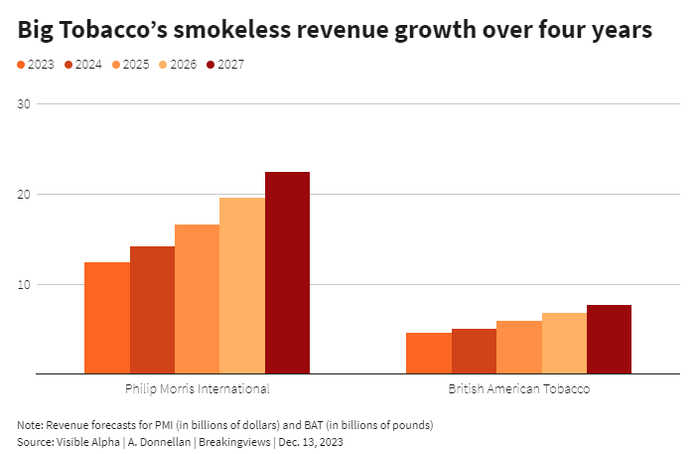Published 15:21 IST, December 18th 2023
Big Tobacco’s smoke-free rush may soon burn out
The industry’s hope is now on smokeless products like PMI’s IQOS tobacco sticks, a pen-like device which releases a vapor that tastes like regular cigarettes.
- Republic Business
- 5 min read

Artificial high. Teenage smokers who inhale too quickly can feel nauseous and dizzy. That’s a risk for investors banking on smoke-free products to turbocharge the sales of Big Tobacco stocks like Philip Morris International and British American Tobacco. With countries from Australia to the UK clamping down on vapes, snus and the like, there’s a danger the sector’s rosy valuations go up in smoke.
Traditional cigarettes are burning down to their butts. Social stigma against a product that kills 8 million people a year, public bans, and high taxes all mean that fewer and fewer people smoke. The proportion of U.S. smokers had fallen to a record low of 11.5% as of 2021, from 21% in 2005. Companies have managed to compensate by whacking up prices on those desperate enough to keep up the habit, but the long-term trend is clear. The World Health Organization reckons 60 countries are on track to reach a 30% reduction in tobacco use between 2010 and 2025.
Big Tobacco has therefore embarked on a dramatic pivot. The industry’s hope is now on smokeless products like PMI’s IQOS tobacco sticks, a pen-like device which releases a vapor that tastes like regular cigarettes but has fewer harmful chemicals. There’s also snus – tiny tobacco sachets worn on the gum – and similar nicotine pouches. Then there’s vaping, popular with teenagers, which comes in a variety of flavours and colourful devices.
These products appeal to Big Tobacco because they are deemed healthier than ordinary cigarettes, which means they can be sold to a much larger pool of consumers. The smokeless market reached some $90 billion in 2022, and analysts reckon its rapid growth will continue. PMI and BAT’s revenue from smoke-free goods is set to grow by 16% and 14% a year respectively between 2023 and 2030, according to Visible Alpha forecasts. BAT Chief Executive Tadeu Marroco said in December that he wants pouches, pens and the like to make up 50% of sales by 2035.
Such toppy growth expectations are baked into tobacco company valuations. Start by working out what the traditional cigarette businesses are worth. One yardstick is UK-listed Imperial Brands, which is a laggard in smoke-free products and last year made over 90% of its revenue from traditional tobacco brands like Winston or Golden Virginia. Including debt, it is currently trading at 2.5 times 2024 sales, per Visible Alpha data. Using that same multiple, PMI’s combustible business would be worth $55 billion, or just under a third of its $188 billion enterprise value. That implies that the smoke-free business is worth $134 billion, over 9 times 2024 sales, again using Visible Alpha data. On that same logic, BAT’s 2024 revenue from vaping and similar products is valued on a multiple of nearly 7 times. That’s above where fast-growing technology groups trade: companies in the Nasdaq 100 Index are on average worth around 5 times sales, according to LSEG data.

These rosy forecasts and valuations, however, are at odds with growing concerns from regulators and governments. Many politicians fear e-cigarettes and similar products are creating a new generation of nicotine addicts. They also produce a number of dangerous chemicals, including acetaldehyde, acrolein and formaldehyde, which the American Lung Association says can cause lung as well as heart disease. So far, no product is exempt from attacks. Singapore banned vaping in 2018 and fines offenders up to $2,000. Last year, the European Union banned flavoured heated tobacco products. In the UK politicians are discussing making vapes only available to people with a doctor’s prescription, a measure Australia recently introduced. Meanwhile, snus is banned across the EU.
Outright bans are not the only threat. Raising taxes is a particularly attractive weapon for governments, as it allows them both to replace revenue from lower levies on traditional cigarettes and discourage new addicts. Malaysia has introduced a tax on chewing tobacco and the UK is considering adding an extra charge on vaping products on top of VAT. Traditional cigarettes have shown that higher taxes can cripple demand: according to the American Lung Association every 10% increase in the price of cigarettes reduces consumption by about 4% in adults and about 7% in young people.
If more countries pile on the regulation and tax bandwagon, the likes of PMI and BAT face a double blow. They will see their core product of cigarettes diminish more quickly, and the pace of growth in their vaping and other new products fail to live up to expectations. Big Tobacco’s hopes for a more prosperous and less regulated future may soon burn out.

Context News
British American Tobacco on Dec. 6 said it plans to build a “smokeless world” and to generate 50% of the company’s revenue from non-traditional cigarettes by 2035. The London-listed company also announced a $31.5 billion impairment on some U.S. cigarette brands at its full-year pre-close trading update. The maker of Lucky Strike cigarettes maintained its full-year revenue growth forecast at 3%-5% in constant currency, but said it expects it to be at the lower end of this range. BAT also said it expects low-single-digit growth in revenue and adjusted profit from operations in 2024.
Author: Aimee Donnellan
Updated 12:52 IST, December 19th 2023